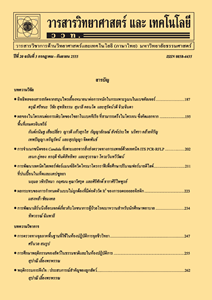ประสิทธิภาพของน้ำมันหอมระเหยจากเมล็ดพริกไทยดำคัดทิ้งในการควบคุมเพลี้ยอ่อนถั่ว, Aphis raccivora Koch (Homoptera: Aphididae)
Main Article Content
Abstract
The repellent, insecticidal and developmental inhibitory activities of essential oils form discarded black pepper seed were tested on the cowpea aphid, Aphis craccivora Koch. The various concentrations of essential oils form discarded black pepper seed 0, 10, 20, 30, 40 and 50 µL/Lair were applied. The treatments were arranged in a completely randomized design (CRD) and replicated 5 times on 10 adults and experiment was conducted at laboratory biology. The results found that the essential oils form discarded black pepper seed at the concentration of 50 µL/Lair of essential oils form discarded black pepper seed was effective as repellent on the cowpea aphid. The repellent of cowpea aphid was 9.60±0.48 adults (PR = 92 %) at 12 h and the highest 10.0±0.00 adults (PR = 100 %). The insecticidal activity, at 50 µL/Lair of essential oils form discarded black pepper seed was effective as insecticidal activity on cowpea aphid. The percent of mortality was the highest 7.60±0.74 adults (76 %) and LC50 value with 36.54 µL/Lair at 24h and 10.00±0.00 adults (100 %) and LC50 value with 22.86 µL/Lair at 48h. At 10 µL/Lair of essential oils form discarded black pepper seed was effective as developmental inhibitory activity on cowpea aphid. The number of progeny was 2.50±0.47 adult and percent progeny was 25 % whereas the control, the number of progeny was 8.00±0.99 adult and percent progeny was 80 %.
Keywords: essential oil; discarded black pepper seed; cowpea aphid; Aphis craccivora
Article Details
References
[2] Vasavirama, K. and Upender, M., 2014, Piperine: A valuable alkaloid form piper species. Int. J. Pharm. Sci. 6(4): 34-38.
[3] Blackman R.L. and Eastop, V.F., 2000, Aphids on the World’s Crops: An Identification and Information Guide, 2nd Ed., John Wiley and Sons, Chichester, 476 p.
[4] Emden H.F.V. and Harrington, R., 2007, Aphids as Crop Pests, Wallingford Oxfordshire Press, United Kingdom, 677 p.
[5] Damiri, B.V., Al-Shahwan, I.M., Al-Saleh, M.A., Abdalla, O.A. and Amer, M.A., 2013, Identification and characterization of cowpea aphid-borne mosaic virus isolates in Saudi Arabia, J. Plant Pathol. 95: 79-85.
[6] Obopile, M., 2016, Economic threshold and injury levels for control of cowpea aphid, Aphis craccivora Linnaeus (Homoptera: Aphididae) on cowpea, Afr. Plant 12: 111-115.
[7] Dey, K.R., Choudhury, P. and Dutta, B.K., 2013, Impact of pesticide use on the health of farmers: A study in barak valley, Assam (India), J. Environ. Chem. Ecotoxicol. 5: 269-277.
[8] Pérez, C.J., Alvarado, P., Narváez, C., Miranda, F., Hernández, L., Vanegas, H., Hruska, A. and Shelton, A.M., 2000, Assessment of insecticide resistance in five Insect pests attacking field and vegetable crops in Nicaragua, J. Econ. Entomol. 93: 1779-1787.
[9] Koul, O., Walia, S. and Dhaliwai, G.S., 2008, Essential oils as green pesticides: Potential and constraints, Biopes. Int. 4: 63-84.
[10] Scott, I.M., Jensen, H., Nicol, R., Lesage, L., Bradbury, R., Sánchez-Vinda, P., Poveda, L., Arnason, J.T. and Philogène, B.J.R. 2004, Efficacy of Piper (Piperaceae) Extracts for control of common home and garden insect pests, J. Econ. Entomol. 97: 1390-1403.
[11] Srivastava, A.K. and Singh, V.K., 2017, Biological action of Piper nigrum – the king of spices, Eur. J. Biol. Res. 7: 223-233.
[12] Fan, L.S., Muhamad, R., Omar, D. and Rahman, M., 2011, Insecticidal properties of Piper nigrum fruit extracts and essential oils against Spodoptera litura, Int. J. Agric. Biol, 13: 517-522.
[13] กันยารัตน์ มาแย้ม, อรพิน เกิดชูชื่น และณัฏฐา เลาหกุลจิตต์, 2556, การวิเคราะห์สารสำคัญจากพืชวงศ์ Piperaceae สำหรับนำมาใช้ในการควบคุมด้วงงวงข้าวโพด, ว. วิทย์. กษ. 44(2)(พิเศษ): 45-48.
[14] สำนักงานเศรษฐกิจการเกษตร, 2551, พริกไทยจันทบุรี : พืชเศรษฐกิจที่ชาวสวนต้องรักษาไว้, แหล่งที่มา : http://www.oae.go.th/ewtad min/ewt/oae_baer/ewt_news.php?nid=390&filename=index, 1 พฤษภาคม 2560.
[15] กนกอร วุฒิวงศ์, อรัญ งามผ่องใส และเยาวลักษณ์ จันทร์บาง, 2558, การออกฤทธิ์ขับไล่ด้วงงวงข้าวโพด (Sitophilus zeamais Motschul-sky) ของน้ำมันจากพืชบางชนิด, แก่นเกษตร 43(1)(ฉบับพิเศษ): 145-150.
[16] Khani, M., Awang, R.M. and Omar, D., 2012, Insecticidal effects of peppermint and black pepper essential oils against rice weevil, Sitophilus oryzae L. and rice moth, Corcyra cephalonica (St.), J. Med. Plants 11: 97-110.
[17] Poole, R.W and Gentili, P., 1996, Cowpea aphid, Aphis craccivora Koch 1854, Availble source: https://www.insectimage s.org/browse/subthumb.cfm?sub=81, 16 July 1, 2016.
[18] Finney, D.J, 1971, Probit Analysis, 3rd Ed, Cambridge University Press, London.
[19] Abbott, W.S., 1925, A Method for computing the effectiveness of an insecticide, J. Econ. Entomol. 18: 265-267.
[20] Abtew, T., Subramanian, S., Cheseto, X., Kreiter, S., Garzia, G.T. and Martin, T., 2015, Repellency of plant extracts against the legume flower thrips Megalurothrips sjostedti (Thysanoptera: Thripidae), Insects 6: 608-625.
[21] Upadhyay, R.K. and Jaiswal, G., 2007, Evaluation of biological activities of Piper nigrum oil against Tribolium castaneum, Bull. Insectol. 60: 57-61.
[22] Martins, A.P., Algueiro, L.S., Vila, R., Tomi, F., Canaigueral, S., Casanova, J., Cunha, A.P.D. and Adzet, T., 1998, Essential oils form four Piper species, Phytochemistry 49: 2019-2023.
[23] Aref, S.P. and Valizadegan, O., 2015, Fumigant toxicity and repellent effect of three Iranian Eucalyptus species against the lesser grain beetle, Rhyzopertha dominica (F.) (Col.: Bostrichidae), J. Entomol. Zool. Stud. 3: 198-202.
[24] Wubie, M., Negash, A., Guadie, F., Molla, G., Kassaye, K. and Raja, N., 2014, Repellent and insecticidal activity of Mentha piperita (L.) plant extracts against cabbage aphid [Brevicoryne brassicae Linn. (Homoptera: Aphididae)], Amer.-Eur. J. Sci. Res. 9: 150-156.
[25] Rizwan-ul-haq, M., Hu, M.Y., Afzal, M.,
Bashir, M.H., Gong, L. and Luo, J., 2010, Impact of two medicinal plant extracts on glutathione s-transferase activity in the body tissues Spodoptera exigua (Lepidoptera: Noctuidae), Pak. J. Bot. 42: 3971-3979.
[26] Ashouri, S. and Shayesteh, N., 2010, Insecticidal activities of two powdered spices, black pepper and red pepper on adults of Rhyzopertha dominica (F.) and Sitophilus granarius (L.), Mun. Ent. Zool. 5: 600-607.
[27] Paul, D. and Sohkhlet, D., 2012, Anti-feedant, repellent and growth regulatory eeffects of four plants extracts on Pieris brassiceae larvae (Lepidoptera: Pieridae), Open Access Sci. Rep. 1: 1-5.


